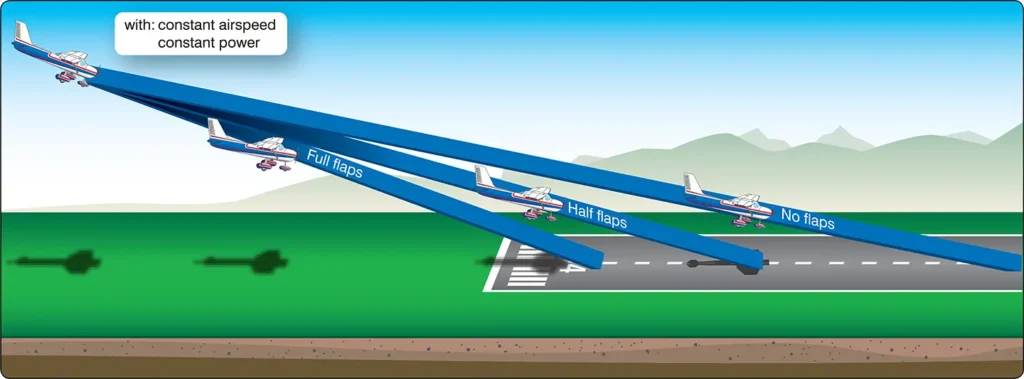The following general discussion applies to airplanes equipped with flaps. The pilot may use landing flaps during the descent to adjust lift and drag. Flap settings help determine the landing spot and the descent angle to that spot. [Figure 1 and Figure 2]


Flap extension during approaches and landings provides several advantages by:
- Producing greater lift and permitting lower approach and landing speeds,
- Producing greater drag and permitting a steeper descent angle,
- Increasing forward visibility by allowing a lower pitch, and
- Reducing the length of the landing roll.
The increased camber from flap deflection increases lift, primarily on the rear portion of the wing. This produces a nose-down pitching moment which may cause the airplane to pitch down. Flap deployment may also affect wing downwash on the horizontal tail and alter the tail-down force. Consequently, pitch behavior from flap extension depends on the design of the particular airplane.
Flap deflection of up to 15° primarily produces lift with minimal drag. The airplane has a tendency to balloon up with initial flap deflection because of the lift increase. The nose-down pitching moment, however, tends to offset the balloon. Flap deflection beyond 15° produces a large increase in drag. Deflection beyond 15° also produces a significant nose-up pitching moment in certain high-wing airplanes because the resulting downwash changes the airflow over the horizontal tail.
The time of flap extension and the degree of deflection are related. Large changes in flap deflection at one single point in the landing pattern can produce large lift changes that require significant pitch and power changes in order to maintain airspeed and descent angle. Consequently, there is an advantage to extending flaps in increments while in the landing pattern. Incremental deflection of flaps on downwind, base leg, and final approach allow smaller adjustments of pitch and power and support a stabilized approach.
Whenever the flap setting is changed, the pilot should be prepared to re-trim the airplane as needed to compensate for the change in aerodynamic forces. Throughout the Approaches and Landings section, more detail is provided on the use of flaps during specific approach and landing situations, as appropriate.
